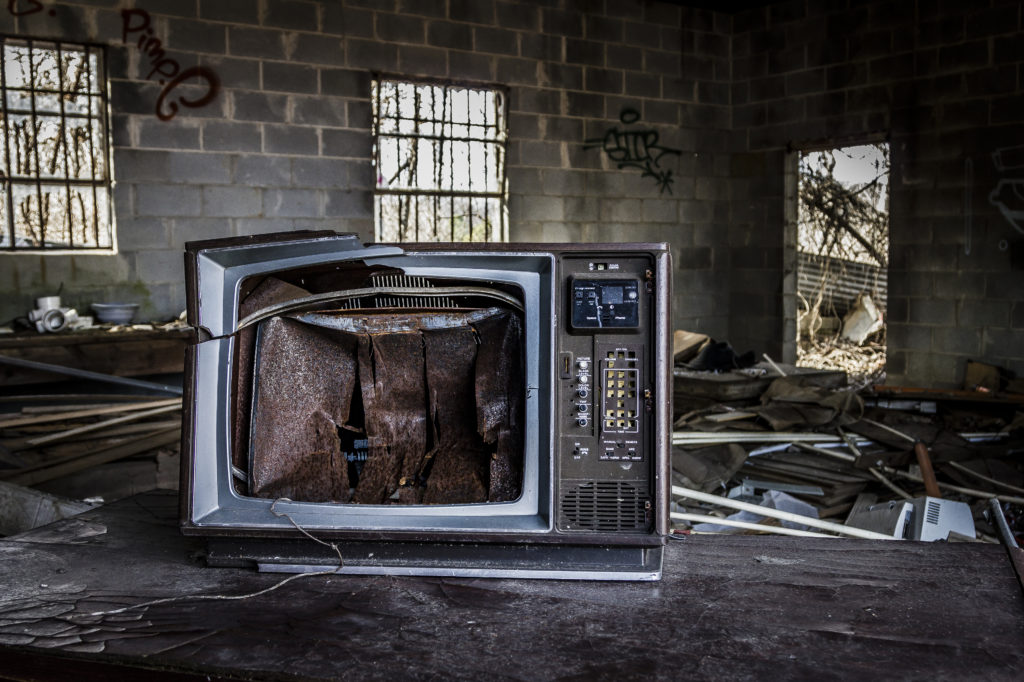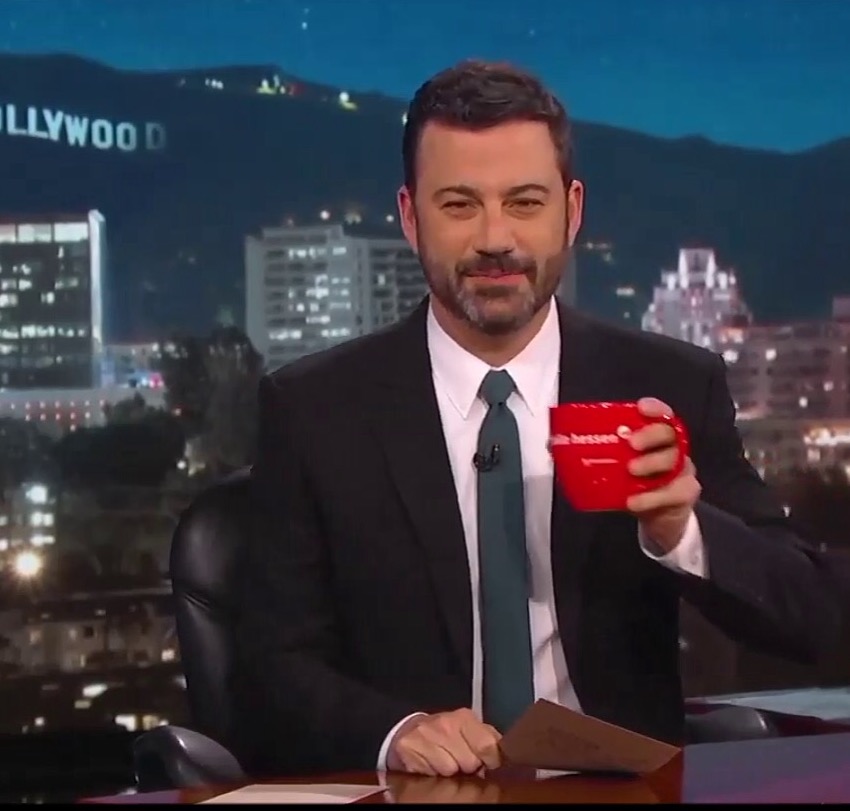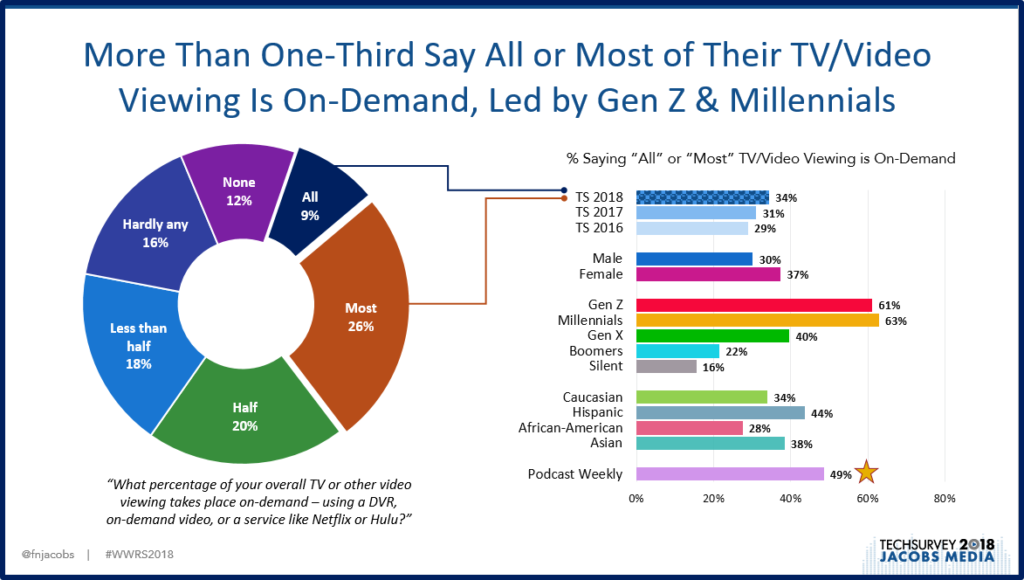
The ways in which consumers now chew through media content continues to morph – especially when it comes to traditional televsion and radio broadcasts. Disruption has been in the air for years now, but the TV world has been especially rocked by on-demand, thanks to DVRs and services like Netflix and Hulu.
Even though our Techsurveys are comprised of radio stakeholders, this year’s study asks a number of questions about television consumption. What, if anything, does that have to do with radio?
Everything. We’re seeing the on-demand habit grow in TV, and there’s a clear connection to the changing ways in which consumers are listening to broadcast radio.
In this post, I’ll show you some of that new data that illustrates the link between these two storied media. But my first piece of evidence is from one of TV’s new icons, former radio host and late night star Jimmy Kimmel. In a recent interview in AdAge by Jeanine Poggi, Kimmel opened up about his ratings, upfront advertsing and other related issues. Here’s the key Q&A sequence:
AdAge: How do you see the late-night landscape evolving as fewer people watch TV live and consume content on multiple platforms and devices?
Kimmel: Fewer people might be watching on TV, but a lot more people are watching. I just got an email like 12 minutes ago  and it gives our YouTube views. We had 43 million new video views last week alone and that’s a typical week. And that’s just YouTube. It doesn’t count Facebook, Hulu, Twitter, anywhere else these videos might be posted. And it only counts the official posting. The truth is, exponentially more people are watching late-night TV than they ever have, including the days of Johnny Carson and “The Tonight Show” and that era of TV when there was only one thing to watch. They’re just watching it in any different ways.
and it gives our YouTube views. We had 43 million new video views last week alone and that’s a typical week. And that’s just YouTube. It doesn’t count Facebook, Hulu, Twitter, anywhere else these videos might be posted. And it only counts the official posting. The truth is, exponentially more people are watching late-night TV than they ever have, including the days of Johnny Carson and “The Tonight Show” and that era of TV when there was only one thing to watch. They’re just watching it in any different ways.
In many different ways.
In the case of television, we’re seeing a rise in the proliferation of “cord cutters” – frequently these are Millennials who have cancelled pay TV to both save money and have more control over what they’re watching.
And as Kimmel correctly points out, there’s a continued increase in those who prefer to watch on-demand TV. In studying Techsurvey results these past few years, we’ve started tracking the decline in real-time television viewing – and it’s real.
They’re seeing the same thing at NBC. Their Entertainment chairman, Bob Greeblatt, told CNN Tech that while his network’s ratings and revenues are decreasing, “30%-40% of viewing of our shows is off the network. As long as I can follow that viewer to Hulu, which we also own, or other platforms, it’s OK with me.”
Techurvey 2018 mirrors those observations. More than a third of our respondents say that all or most of their TV viewing is now on-demand. Not surprisingly, those same “cord cutting” Millennials are most apt to fall into these ranks. But if you look at the very bottom of this chart, you’ll also notice how weekly podcast listeners are also especially more likely to enjoy television in the on-demand format. In fact, nearly half say the lion’s share of their TV viewing has ported over to on-demand.

If you’re expecting another clarion call from me about why you should start podcasting, don’t hold your breath. Yes, podcasting continues to grow, and it even threatens radio listening, as we continue to learn in our Techsurveys. But that’s not the theme behind this post.
The bigger takeaway is buried in Kimmel’s quote – consumers are using sources other than traditional terrestrial ABC TV affiliates to access his content – and radio’s. Our Brand Pyramid shows the fastest growing companies are Netflix, Hulu, and Amazon Prime Video. That should tell us something about how TV is being rocked by on-demand.
Can radio be far behind?
That’s where we’ll journey tomorrow – a look at the different ways radio audiences are using new technologies and distribution outlets to enjoy our programming.
To put the bow on this post, here’s another key question for Kimmel about the future of terrestrial television viewing that has direct applications to broadcast radio:
AdAge: Do you see a time where “Jimmy Kimmel Live!” no longer airs on traditional TV and lives solely in a digital world?
Kimmel: I don’t think so. Starting on TV and that being your jumping off point puts you way ahead of the game. It’s definitely important. It seeds the clouds, and your videos, as a result of being from TV, are more widely shared. We have a big advantage over someone who just posts a video to their YouTube channel and we try to keep pretty closely tied to current events. It becomes a natural part of your daily news.
That’s true for radio as well.
Consumers may be using other channels and platforms to view our content. But that broadcast foundation is the key to having success with other distribution channels.
Advantage: radio.
- What To Do If Your Radio Station Goes Through A Midlife Crisis - April 25, 2025
- A 2020 Lesson?It Could All Be Gone In A Flash - April 24, 2025
- How AI Can Give Radio Personalities More…PERSONALITY - April 23, 2025




FRED,
SORRY I DIDNT GET A CHANCE TO SAY HELLO AT THE JOEL DENVER’S SHINDIG IN L.A..I DID WANT TO TELL YOU HOW MUCH I ENJOY YOUR BLOG, SO I’LL JUST DO IT HERE. GREAT INFO AND IDEA STARTERS, EVEN FOR A PLAIN SIMPLE DEEJAY!
Scott, I’m honored you read it, and very much appreciate you reaching out. We’ll catch up at the next conference. Congrats on all your success and passion for radio.
Perhaps you will address it tomorrow Fred, but aside from podcasts, has Jacobs Media looked specifically in any of its surveys at the value/audience usage of the two-week audio streaming archives some radio stations are offering to allow their audience to easily time-shift?
There are so many options (along with podcasts) to offer, but how is the return on investment on this sort of thing for the average station that has to prioritize resources? Or the ROI on multiple music streams? Or HD-2s & HD-3s?
Dan, in PPM markets, that “evergreen” content in the archives only has a shelf life of 24 hours. That’s whwy it’s essential for stations and shows to post this material as soon after it’s broadcast as possible. So, if consmers listen quickly enough, it accreditve to the ratings. But whether they do or not, good streaming metrics should (eventually) translate into spnosorships, pre-roll video, etc. Hope that helps. Thanks for reading our blog.